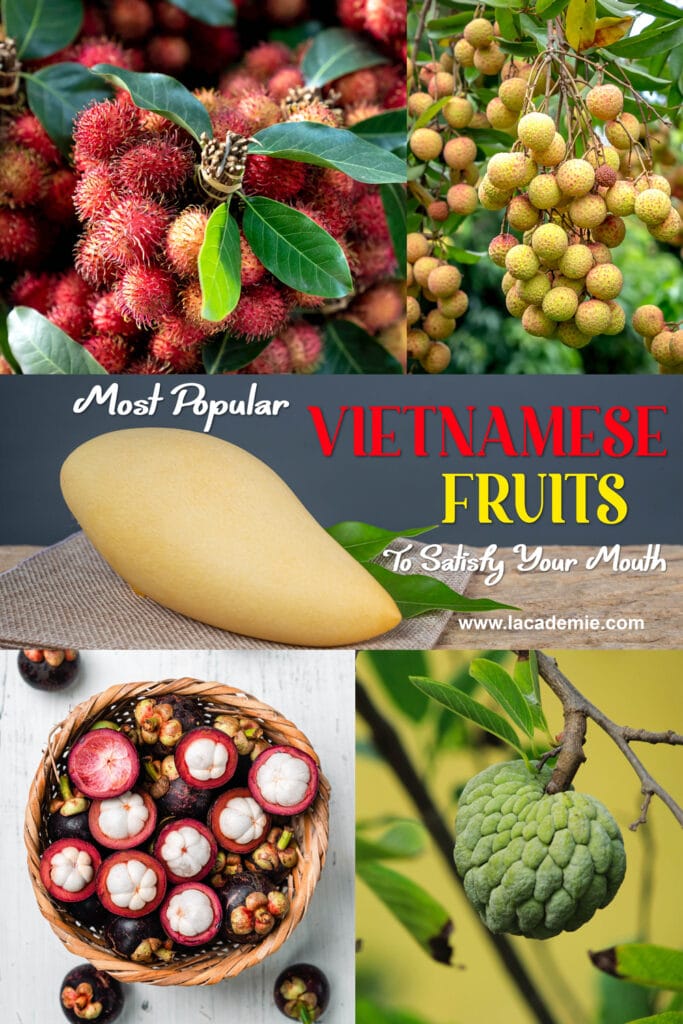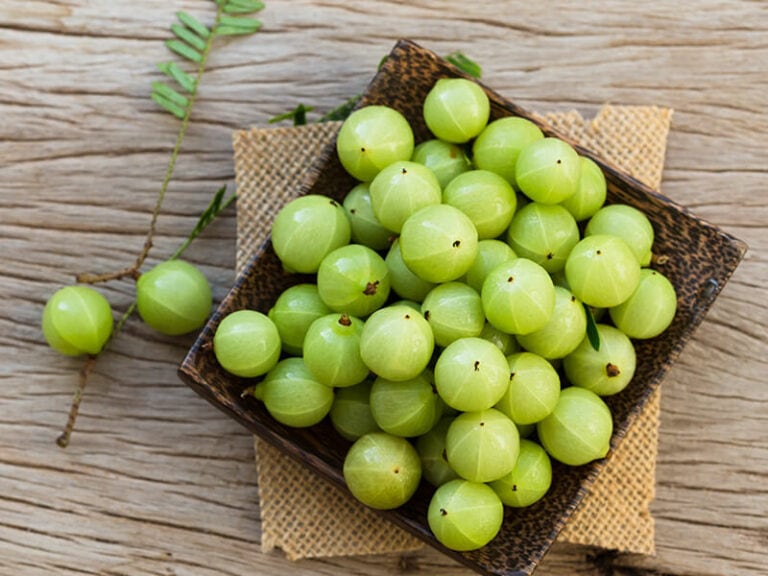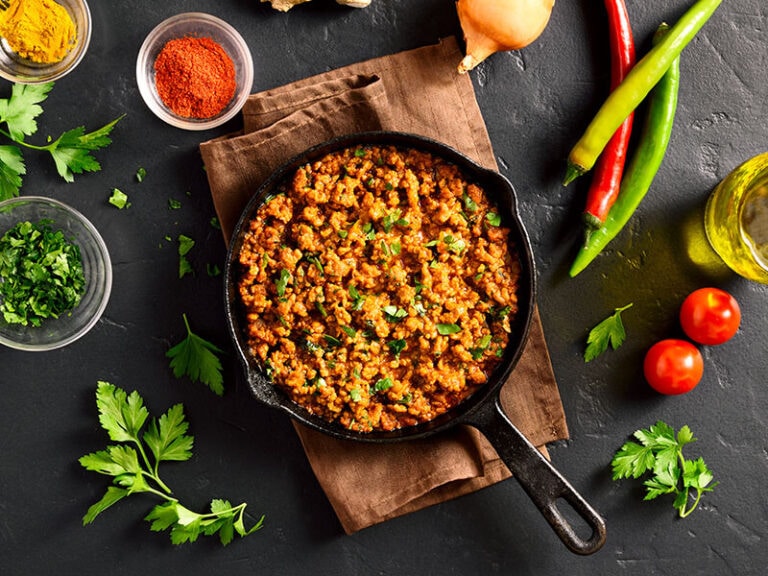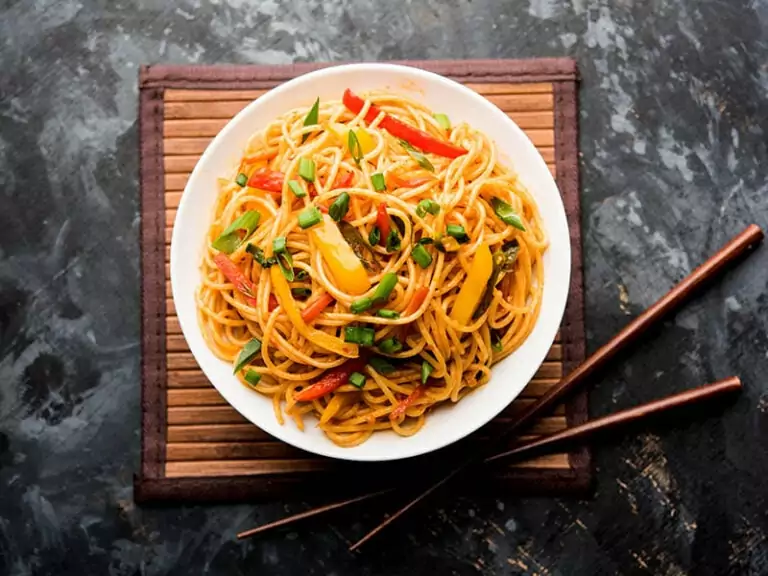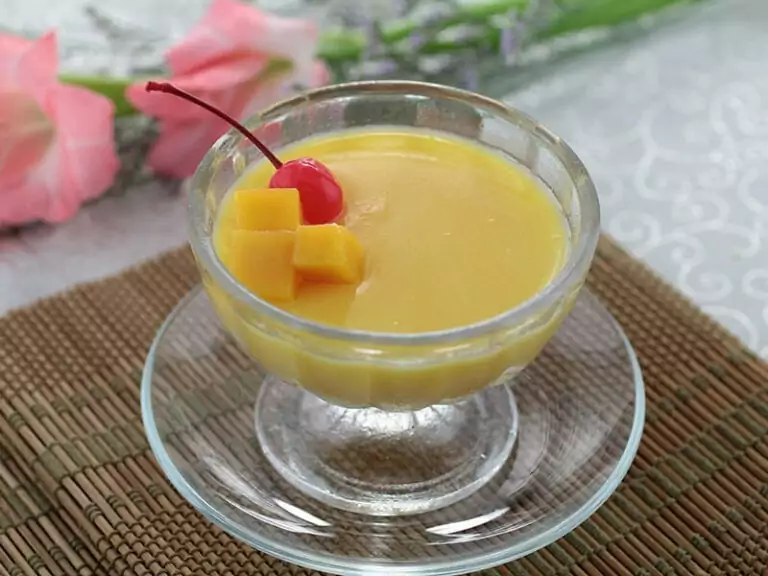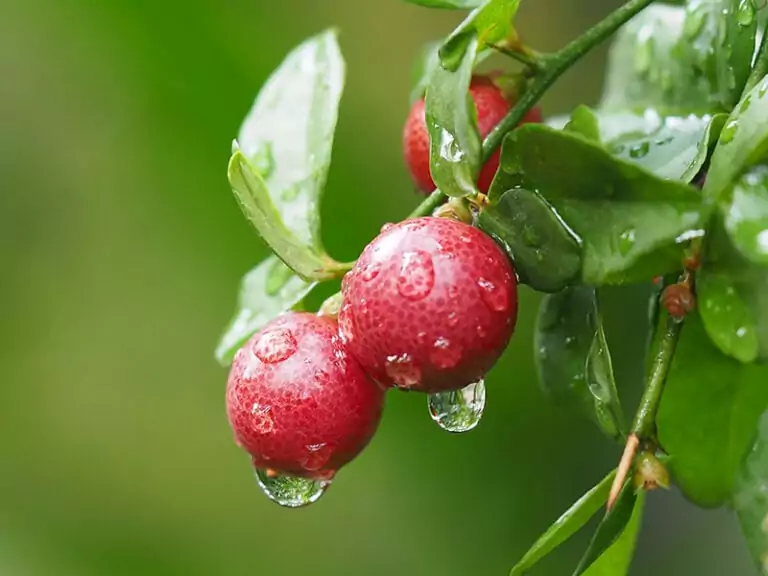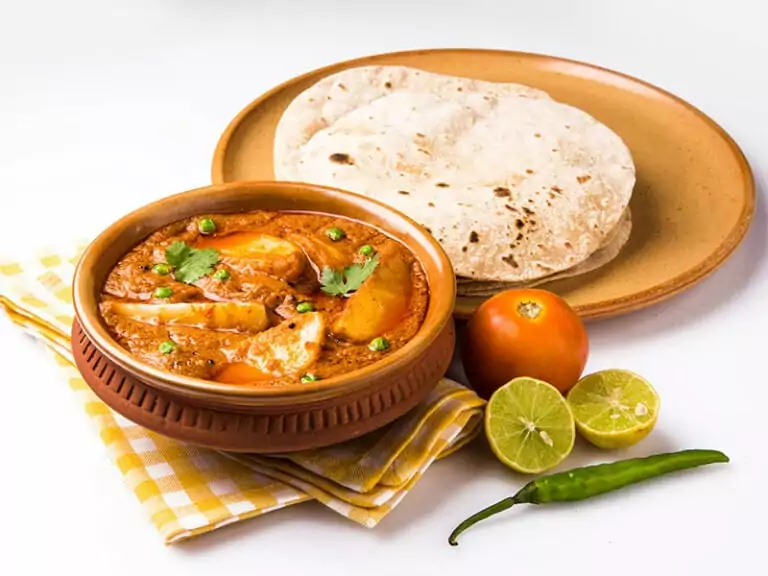There are many incredible Vietnamese fruits you should try when coming to this nation since it is a tropical country. The climate is suitable for the development of many types of fruit. It is time to discover the most popular fruits in this beautiful country.
Vietnamese fruits are diverse, with countless different types. Their flavor also leaves a profound impression on international visitors, and it is also the advantage to attract tourists to this nation. Let’s discover right now.
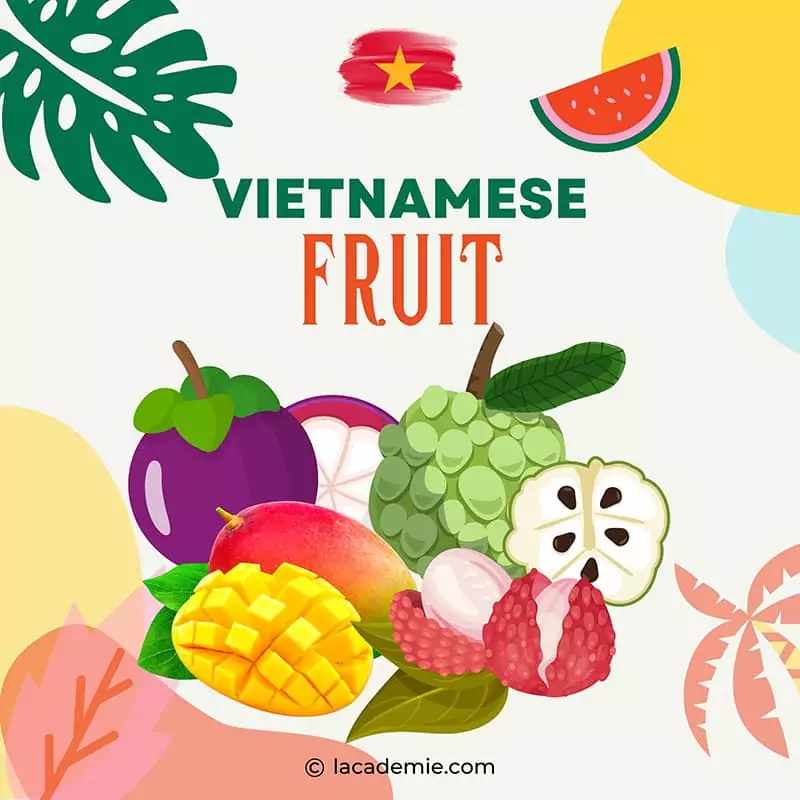
Inedible Seeds
There are many delicious Vietnamese fruits that contain inedible seeds, so you can follow the list in this section to get the right way to consum these fruits when coming to Vietnam.
1. Mangosteen – Măng Cụt
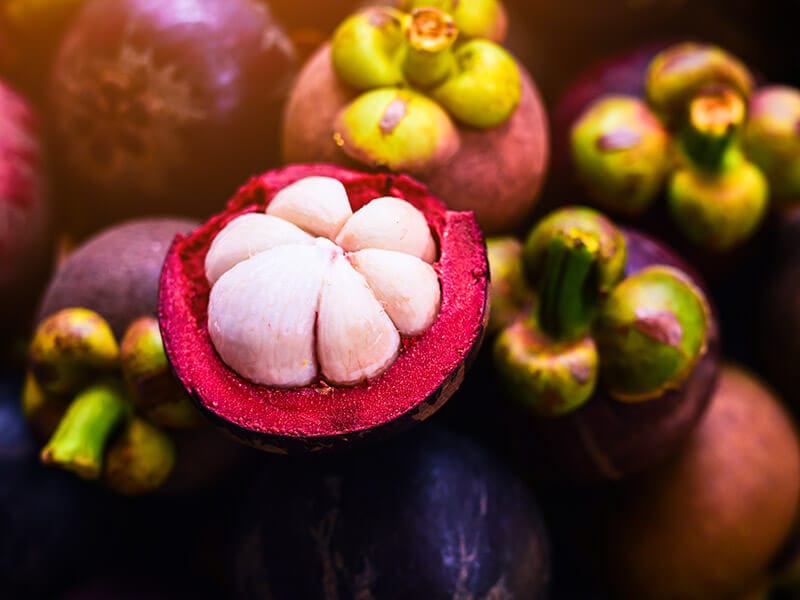
Besides delicious Vietnamese foods, you can fall in love with yummy fruits in this tropical country, and Mangosteen is one of them. It appears in Southeast Asia, Southwest India, and other tropical regions. It is considered the “Queen of Fruit” in Southeast Asian nations.
Mangosteen is prevalent in many regions in Vietnam, especially in the Southeast and Southwest. Vietnamese love mangosteen and it often appears as a dessert after each meal of Vietnamese people.
It usually has thick skin with an eye-catching purple shade. Inside the skin is a light white flesh layer. It has about 5 to 6 citrus per one fruit. Its flesh is tender and has a slightly sweet taste blended with a tangy flavor like pineapple and peach.
Each Mangostee segment will contain a seed. You will immerse yourself in the juiciness of mangosteen while consuming it. Its season in Vietnam often starts in May and ends in September.
Nutrients: Rich in antixiodants, calories, carbs, fiber, vitamin C, B9, B1, and many minerals.
Season: May to August is the peak season of Mangosteen.
How to eat: The most common way to eat Mangosteen is to peel it with a knife and directly eat its flesh, but you should remove the seeds while eating.
Listen to some reviews while eating Mangosteen to understand more about its taste.
2. Custard Apple (Sweetsop) – Mãng Cầu
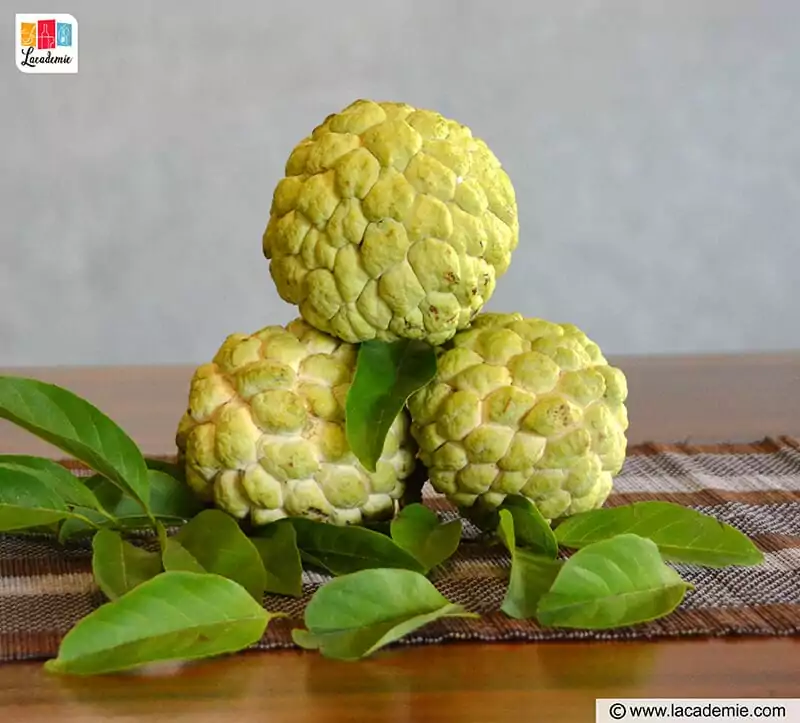
Custard fruit or sweetsop is a popular fruit in Vietnam. It originated in the Americas but has been discovered on Timor island in 1000 CE for the first time. It appears commonly in the Central Highlands and South provinces in Vietnam.
It usually exists in a heart shape. Typically, it has green skin and cracked grooves on the peel surface, creating a texture like the flowers. Its flesh will bring sweet and delicate flavor when ripe. It is often available in July, but it is not ripe at this time.
It has many tiny black seeds, and you should remove them while consuming custard apple. Especially, its fragrance will seduce you immediately. It is one of the 5 fruits that always appear in the five-fruit tray of Southern Vietnamese people in Tet holiday.
There are two main types of Custard Apples, including firm and soft versions. It is easy to find the firm option in the Southern provinces, such as Ba Ria Vung Tau and Ninh Thuan.
Nutrients: It includes calories, proteins, fiber, carbs, vitamin C, and riboflavin.
Season: The primary season lasts from June to September.
How to eat: The most effective way to consume custard apple is to peel its green skin and cut or slice it into 2 parts. Use a spoon to eat its flesh, and carefully release the seeds when eating.
3. Rambutan – Chôm Chôm
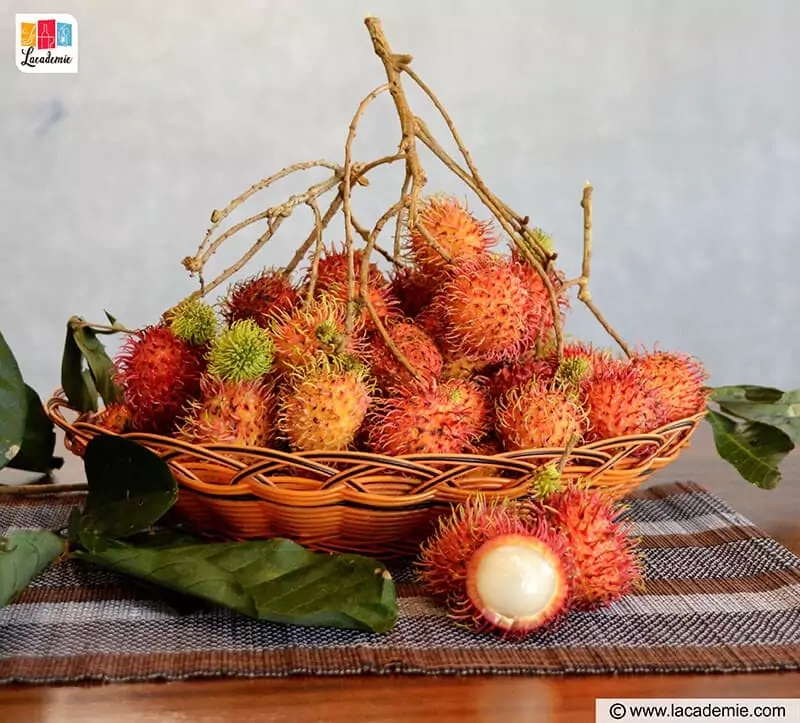
Rambutan is one of the most famous Vietnamese desserts you should not ignore. It is a tropical fruit of the Sapindaceae family. This fruit is native to Southeast Asian countries. The name “Rambutan” originated from the word “Rambut” in Malay, which means “hair”.
Malaysia and Indonesia are regions with a lot of rambutan in the world. Many Malaysian and Indonesian foods are processed from this fantastic fruit. In addition, it also appears in many other tropical regions worldwide.
Its appearance is pretty unique, with countless bright-colored hairs around its red or yellow skin. You will love succulent flesh with the sour and sweet flavor of it. Its flavor is quite similar to grapes. Significantly, the seed in the middle of it is inedible.
It is grown much in the southern and central highlands provinces of Vietnam. You can see many stalls selling rambutan at local markets and on the streets in this country.
Nutrients: It contains carbs, calories, vitamin C, manganese, calcium, potassium, folate, and vitamin A.
Seasons: It is common from May to July in Vietnam.
How to eat: You will use your hand to break its skin and eat its flesh, and you should eat around the pit and leave it away.
4. Lychee – Vải Thiều
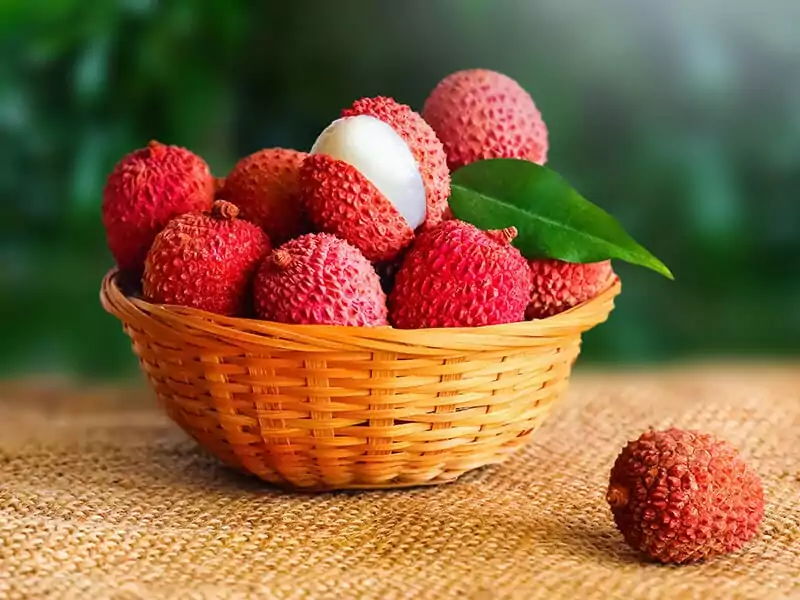
Lychee is a fantastic fruit of the soapberry family. It originated in Guangdong, Yunnan, and Fujian provinces in the southeast and southwest of China. Chinese people began to plant it in the 11th century. China is the most produced country in the world.
In Vietnam, it is loved in every area in this beautiful country. It is cultivated much in the northern provinces of Vietnam. Bac Giang and Hai Duong provinces are the primary source of Lychee to local markets across the nation.
You can easily identify lychee thanks to its red-pink hard skin. Small sharp protuberances will surround the skin to create a distinctive texture. After removing the skin, the opaque white and thick flesh will excite you.
Its flavor is similar to the mixed taste of strawberry and watermelon. Its sweetness and freshness will addict you immediately. In addition, a charming and robust aroma will awake you instantly. Remember to remove its dark brown seed after eating.
Nutrients: It is a source of carbs, fat, vitamin C, magnesium, phosphorus, and potassium.
Season: Its peak season extends from mid-June to mid-July.
How to eat: You only need to peel its skin, eat the flesh, and remove the seed.
Discover some essential information about Vietnamese Lychee.
5. Mango – Xoài
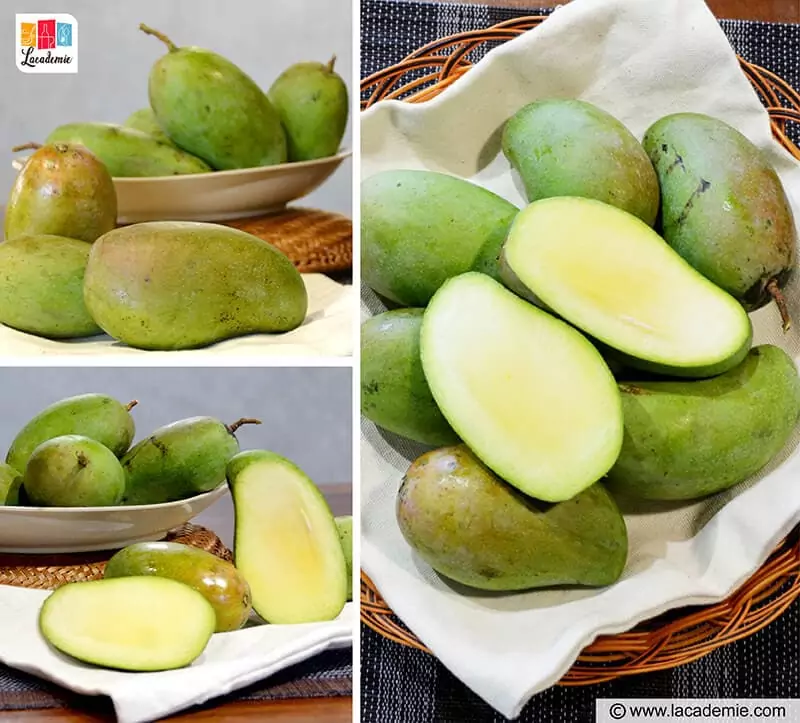
Mango is a fruit that you can find year-round in Vietnam. Most Vietnamese love it and use it for many parties. It has appeared in Southeast and South Asia since ancient times. There are two main types of mango, including Indian mango and Southeast Asian mango.
It appears in a lot of Indian foods and Southeast Asian foods. There are several hundreds of mango variants around the world with countless colors, shapes, and sizes. Mango appears everywhere in Vietnam, from North to South. People in Saigon often enjoy it as street food.
Typically, Vietnam mango has a thin orange-yellow or yellow skin when ripe and green when unripe. It has thick and succulent flesh, and an extensive seed will be in the center of the meat. Vietnamese often eat unripe mango with salt or make salads.
Unripe Mango will bring sourness and sweetness. A ripe mango will have a sweet flavor and soft texture. Most Vietnamese love to eat unripe mango more since it is crispy and delicious.
Nutrients: You can get a lot of calories, carbs, vitamin C, and folate from mango.
Season: It is available from April to July (main season) and another season from January to February.
How to eat: You can peel its skin and eat directly. However, it is best to slice around its seed. Slice crosshatch patterns on its flesh and push it up.
6. Jackfruit – Mít
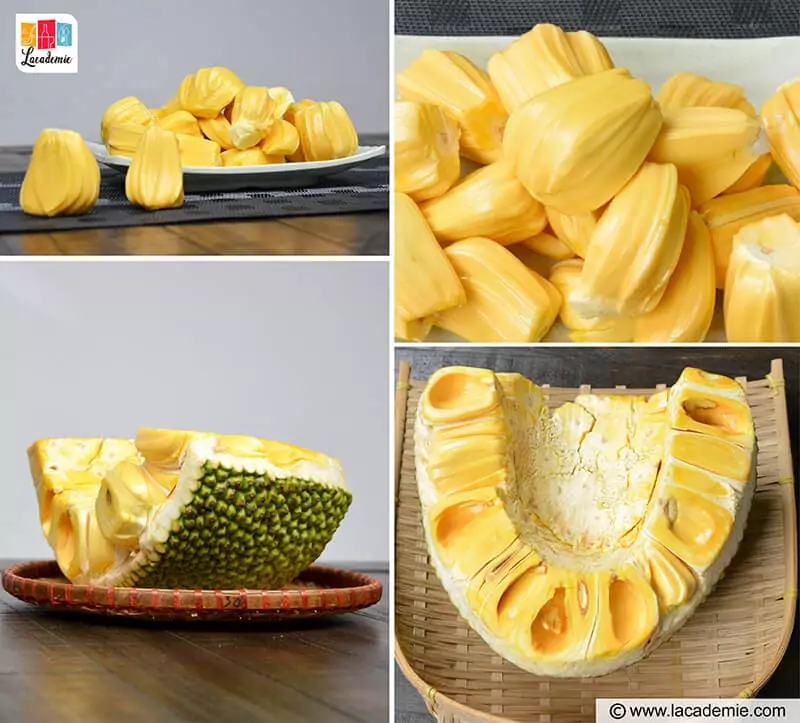
When referring to the favorite Vietnamese fruits, you can’t forget jackfruit. There are many different types of jackfruit in Vietnam. Nowadays, you can find this fruit whose name starts with J in many other regions: the Western Ghats of India, Sri Lanka, and Southeast Asian countries.
It usually grows in length, and Vietnamese jackfruit can weigh from 10 to 15 kilograms. You will be impressed with the yellowish-green (raw) and yellowish-brown (ripe) skin of it. Significantly, the rind has many small and hard pimples that create hexagonal tubercles.
It has a thick and white fibrous inside. Smaller individual fruits will lie around their whitish core. Their shapes are similar to eggs and have a typical bright yellow. Each small fruit will contain an ample seed, and a jackfruit has about 100 to 500 seeds.
The fragrance of the jackfruit will defeat you right away. When ripe, you can smell its aroma when standing from a long distance. The sweetness and crunchiness of flesh will make you lute. It contains many vitamin C and good minerals for the skin and bones.
Nutrients: Rich in carbs, protein, dietary fiber, vitamin B6, vitamin C, potassium, and other minerals.
Season: People often harvest jackfruit all year-round, but the best time is from June to August.
How to eat: Use a knife to cut the jackfruit into 2 halves and use your hand to separate its sections. Remove seeds and enjoy its flesh.
7. Longan – Nhãn
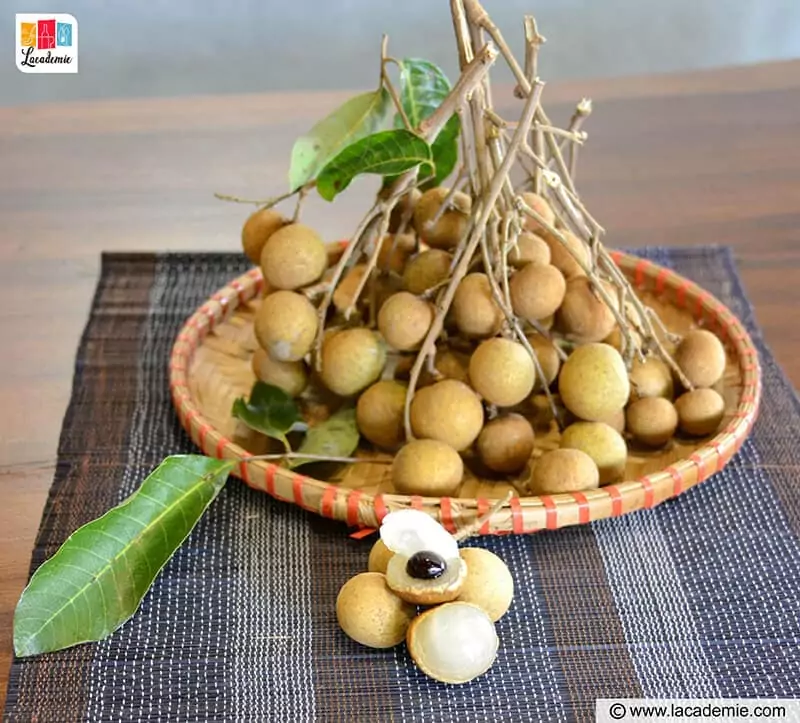
Longan originates from Southern China, and it is common in Asian tropical countries. Records of longan existed from the Han Dynasty in 200 BC. It is well-known in many provinces, such as Hung Yen, Can Tho, and Vinh Long in Vietnam.
This fruit that has a brown color is similar to lychee when surrounded by thick and problematic skin, but its peel surface is smooth. It has a black round seed in the middle that looks like eyeballs. A white and succulent flesh will surround the seed.
Its flesh is often soft, juiciness and sweet. You can think of jelly when eating longan because of the similarity in texture. The longan season in Vietnam usually starts from July to August, but it will take place earlier in the northern provinces.
Nutrients: Plenty of carbs, calories, vitamin C, riboflavin, and potassium.
Season: It is ripe from July to September (peak season falls in August).
How to eat: The fastest way to eat Longan is to peel its skin and eat its flesh. Sometimes, you can slice a line on its flesh and get the seed before eating to create aesthetics.
Explore the health benefits of consuming a lot of Longan.
8. Durian – Sầu Riêng
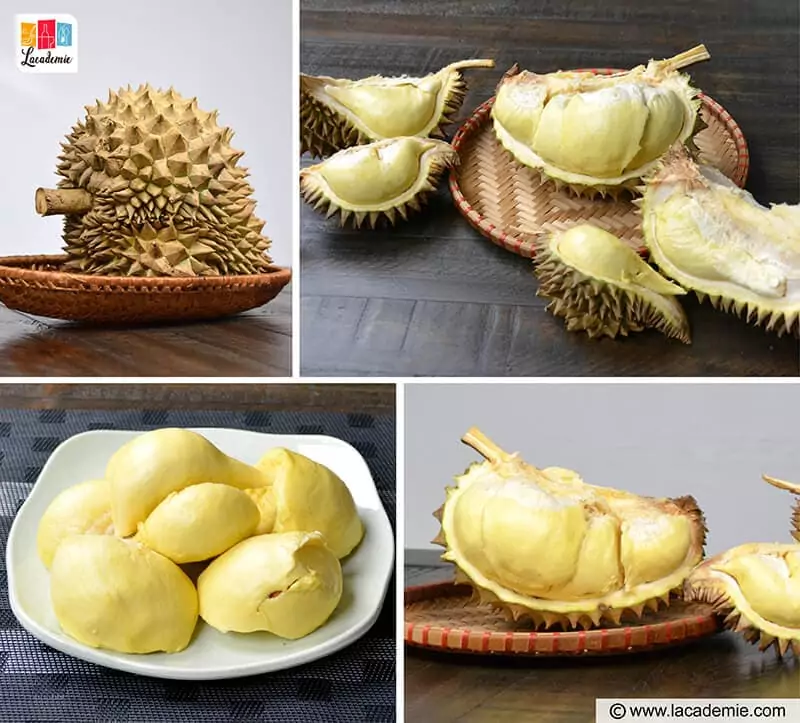
Durian is considered the “King of Fruits” in Vietnam and many Southeast Asian countries. It originated in the Borneo and Sumatra region of the Malay Peninsula. Southern Vietnam and Thailand are the areas growing many durians.
You will feel sweet, salty, and creamy flavors when eating durian. Many people believe that its taste is similar to diced garlic and caramel whipped cream. The Vietnamese make use of this sweetness to create many delicious desserts, such as Che Thai. In addition, durian’s aroma is intense and characteristic.
A mature durian is about 12 inches long and has a diameter of about 6 inches. It usually has a round or oblong shape. Its appearance is pretty similar to jackfruit with thick and hard skin. There are a lot of sharp spikes on the skin. Its skin can leave wounds on your skin.
Its flesh usually has bright yellow, and there will be about 4 to 5 seeds inside this fascinating flesh layer. In Vietnam, durian has different types and is sold popularly at stalls or vendors on the streets.
Nutrients: It provides carbs, fat, thiamine, vitamin B, C, manganese, fiber, oleic acid, and palmitic acid for your body.
Season: In the lowland, its season starts in May and peaks in June. The harvest season peaks from August to September in the highlands. In general, it is possible to consume Durian from May to September.
How to eat: To enjoy durian, you will use a knife to separate its rind (you should be careful as its thorns can hurt you). Get sections out of durian and eat flesh around the seed.
9. Soursop – Mãng Cầu Xiêm
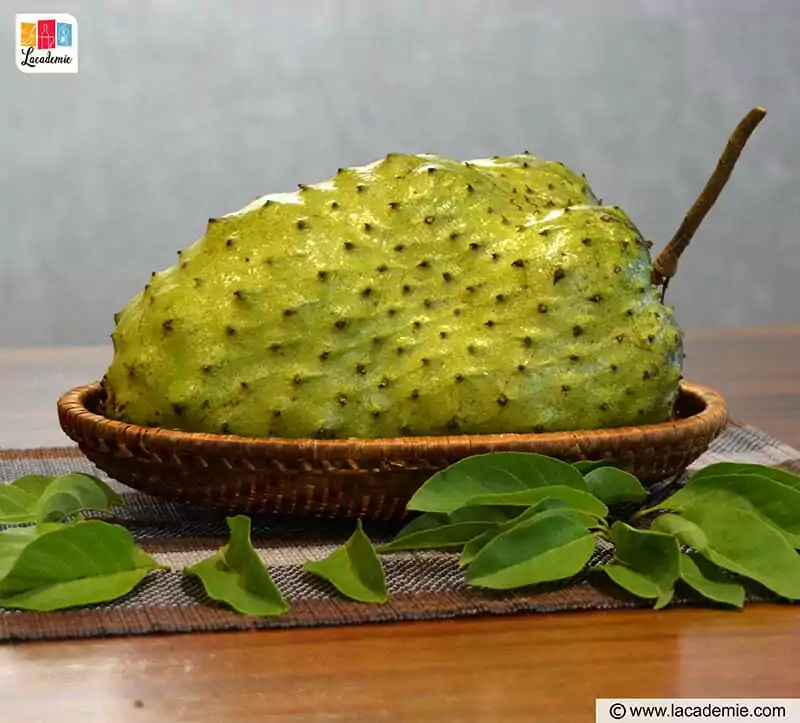
It is a pity not to mention soursop in the list of common Vietnamese fruits. Soursop is native to the Americas and Caribbean. It is widely grown in tropical countries worldwide. It will thrive well in the high humidity areas.
Compared to sweetsop, it has a large size when about 12 inches long. It has an oval form with dark green and prickly colored skin. In particular, you will become addicted to its juicy flesh. Usually, it will have a sour and sweet taste and an attractive aroma.
You can think of pineapple because its aroma is pretty similar. Vietnamese often take advantage of its white pulp to create a fresh smoothie or juice. In addition, it is also a standard option for making cady, sorbets, and ice cream.
Nutrients: Add carbs, calories, vitamin C, iron, magnesium, and potassium from Soursop.
Season: It main season lasts from June to September and another season runs from January to March.
How to eat: It is straightforward when you just need to cut it into 2 parts and take a spoon to get the flesh to consume. Remember to discard its seeds.
It is time to try Soursop to get the real feelings about its flavor.
10. Avocado – Bơ
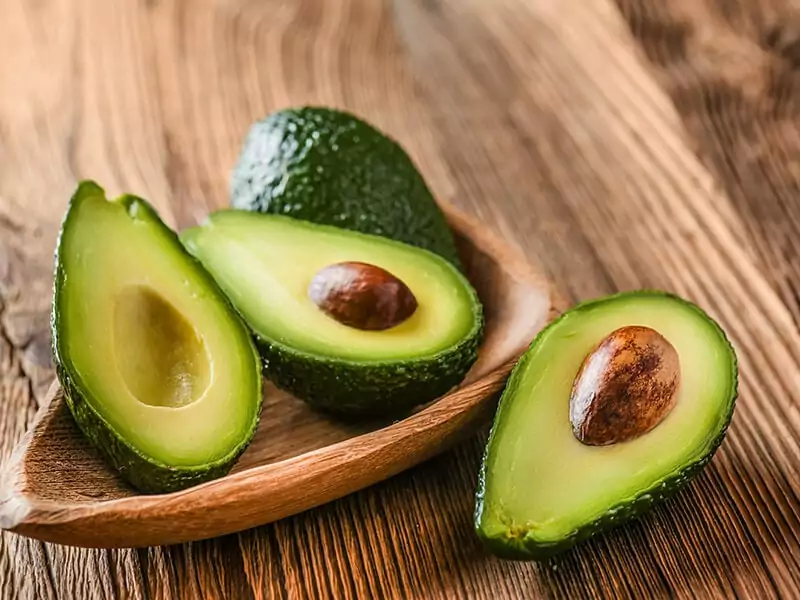
Avocado appears all over the world. It originated in the highland areas in Central and South Mexico and Guatemala. Avocados will grow well in tropical regions, and of course, Vietnam is an ideal place for its development.
Different types of avocado lead to various colors, sizes, and shapes. You can come across green, brown, black, or purplish hues from a ripe avocado. Its skin is often thin and soft.
I like the tender, smooth, and creamy texture of its flesh. Usually, its flesh has a light blue and gentle fragrance. The flavor of avocado is relatively mild, and you can find earthy, grassy, and nutty tastes when enjoying butter.
Avocado is considered a type of large berry as it has a large seed in the middle, and obviously, you should not prepare any food with its seed. In Vietnam, avocado season often lasts from February to August, and the main season extends from May to July or September.
Nutrients: A source of carbs, calories, protein, vitamin B, K, C, E, potassium, carotenoids, and phytosterols.
Season: It is common from February to September and the peak season lasts from May to July.
How to eat: Cut avocado into 2 halves vertically take its seed out of the fruit. Use a spoon to get its flesh to consume.
11. Sapodilla – Hồng Xiêm
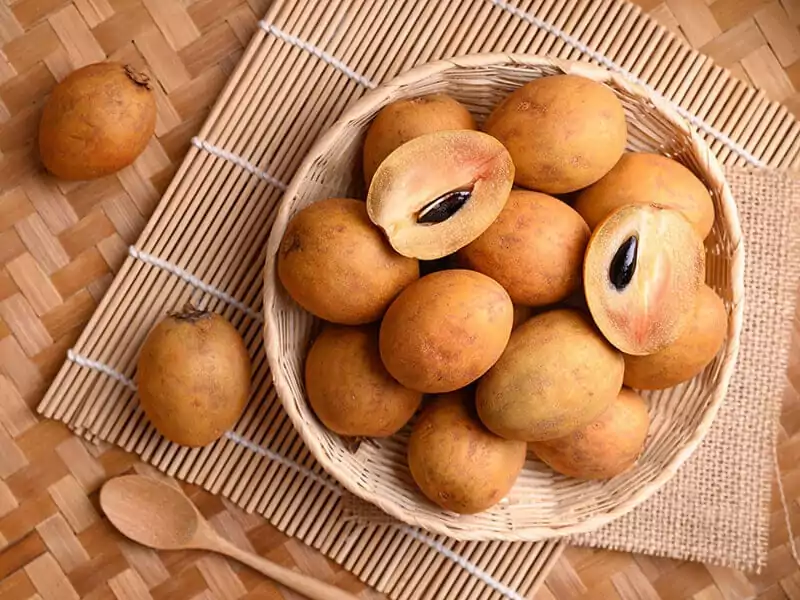
When speaking of famous S-starting fruit in Vietnam, it is impossible not to refer to Sapodilla. It is difficult to find it in Western countries, but it appears throughout Vietnam. You can call it Sapota or Manikara Zapota.
It is a member of the Sapotaceae family with an egg shape. It is native to the North of Vietnam with a mixed flavor of apple, banana, and peach. Also, you can think of pear while consuming sapodilla.
Typically, it has brown and thin skin. Its edible flesh has a soft and smooth texture and eye-catching reddish-orange shade. It consists of 3 to 4 black seeds, and it is good to discard them when eating them.
Nutrients: Calories, carbs, fiber, vitamin C, folate, and pantothenic acid.
Season: It has two peak seasons, including February to April and October to December.
How to eat: After washing with water, you will cut it into 2 parts and consume flesh from the skin. If you want to process smoothies or foods with Sapodillas, you should remove its seeds first.
Find out all things about delicious Sapodilla right away.
12. Papaya – Đu Đủ
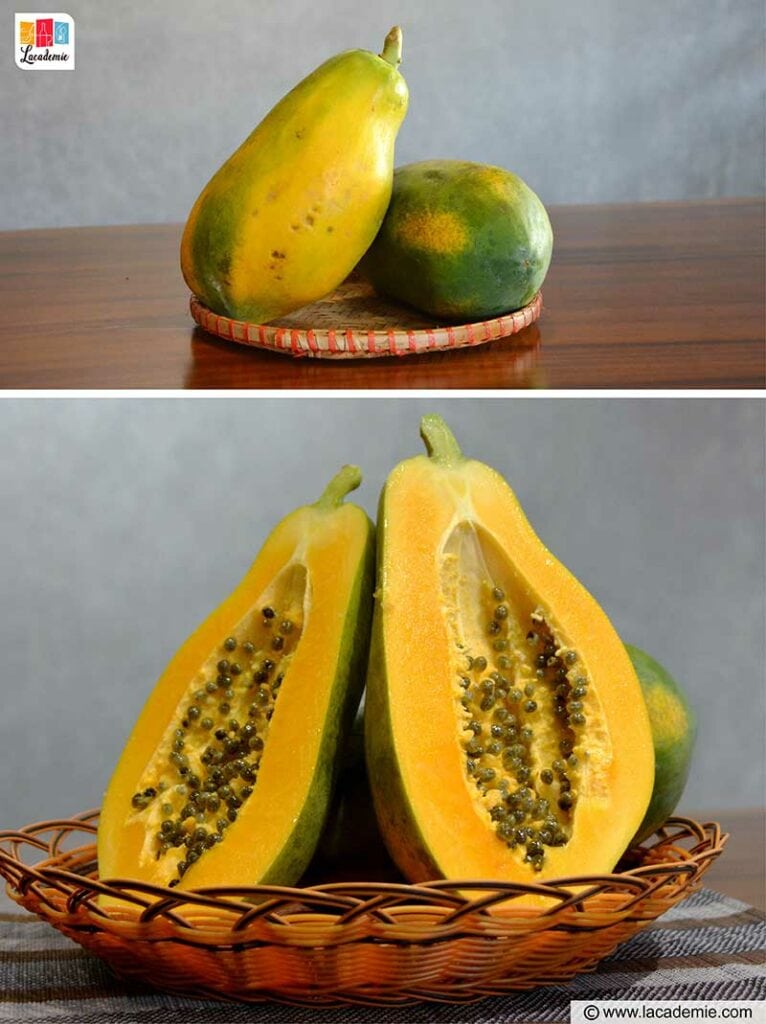
Papaya is an essential fruit in the culture and cuisine of Vietnamese. It appears in the five-fruits tray on the Tet holiday to commemorate the ancestor of the Vietnamese.
It is native to southern Mexico and Central America. Moreover, papaya is also grown in Hawaii, Australia, India, and African countries. Papaya comes in many varieties and usually has 3 genders, including male, female, and hermaphrodite.
Papaya is a large berry with a length of about 5.9 to 17.7 inches and a diameter of about 3.9 to 11.8 inches. Unripe papaya usually has green skin and will turn orange or yellow when ripe. It has many tiny black seeds that are inedible.
Have you ever wondered whether papaya can go bad? Well, the truth is, this fruit can be spoiled quite quickly, especially if you’ve cut it into cubes. Remember to store your papaya in the fridge for a longer shelf life.
The natural and light sweetness, along with the buttery texture of its flesh, will melt in your mouth. Unripe papaya appears in many Vietnamese and Thai recipes, thanks to its crispness. You should enjoy green papaya salad when coming to Vietnam.
Nutrients: Rich in calories, carbs, fiber, vitamin C, A, folate, and potassium.
Season: It available all year-round and farmers will need to wait about 9 months for papaya to produce fruits after planting.
How to eat: You just need to cut it into slices and remove seeds before eating its flesh for ripe papaya. You can use unripe papaya to make salads by cutting it into thin threads.
13. Rose Apple – Mận
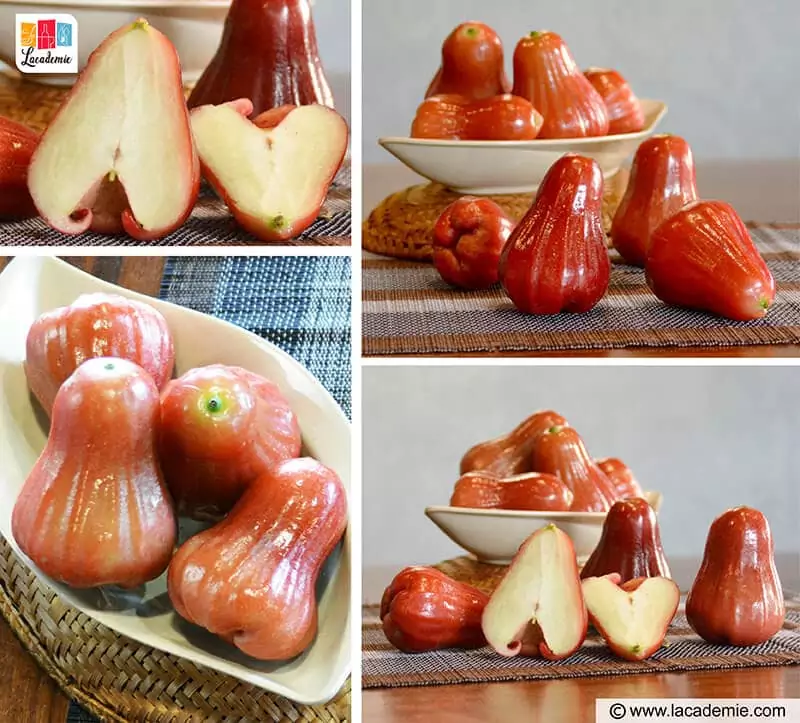
Rose apple has become a familiar dessert fruit of Vietnamese people. It is a typical fruit of Southeast Asia when appearing in many other countries. It originated in the East Indies and Malaya.
Rose apple looks like a bell. It is coated with a smooth and red-colored skin layer. You will be impressed with the crunchiness and juiciness of rose apple. Its flavor is pretty gentle and similar to the taste of unripe guava.
Occasionally, you will feel the taste of rosewater when enjoying it, so it has the name “rose apple”. This fruit is grown a lot in the Mekong Delta region. Its nutritional elements are good for the digestive and immune systems.
Nutrients: It is time to add protein, fiber, calcium, vitamin A, C, and iron with Rose Apple.
Season: It is often ripe from May to September and November to March in Vietnam.
How to eat: The easieast way to eat Rose Apple is to remove its bottom part. Then, cut it into 2 slices and remove the seeds. You can eat it immediately or cut it into smaller pieces.
14. Star Apple (Milk Fruit) – Vú Sữa
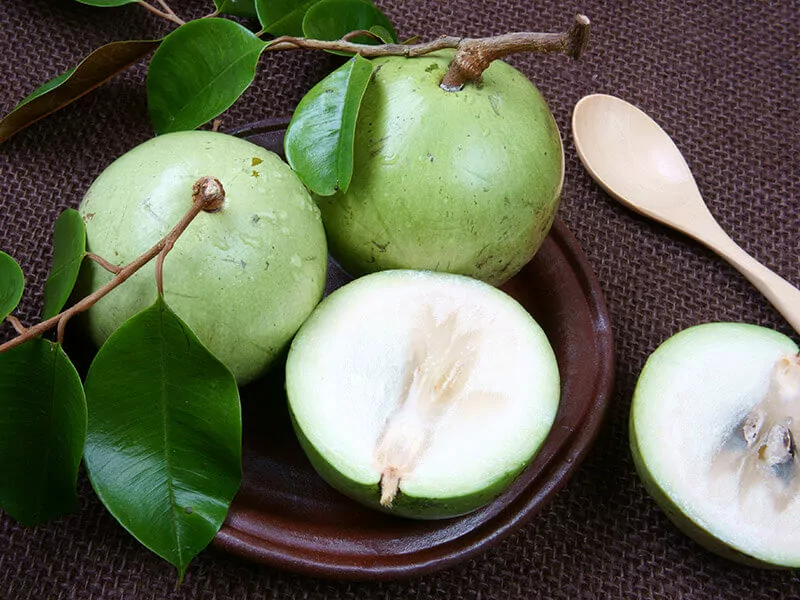
When referring to popular fruits in Vietnam, it is impossible not to mention Star Apple. It is called “Vu Sua” or “Breast Milk” in Vietnam. It originated in the Isthmus of Panama and gradually spread to West Indies and Southeast Asia.
It is widely grown in the Mekong Delta of Vietnam. Star Apple usually has a round shape with 2 to 3 inches diameter. It looks outstanding with purple skin and a faint green area around the calyx.
Inside, you will come across a star pattern stand out in greenish-white pulp. It has a few brown-colored and inedible seeds in the middle. Its sweetness is suitable for enjoying after each meal. The local market sells it popularly from October to December in Vietnam.
Nutrients: A rich source of fiber, protein, vitamin C, B5, folate, potassium, magnesium, and copper.
Season: Its harvest season starts in February or March and peaks in October to December.
How to eat: Twist Star Apple until star shape inside revealed. Discard its seeds and use a spoon to get its flesh out of the skin.
Learn the right method to consume Star Apple immediately.
15. Watermelon – Dưa Hấu
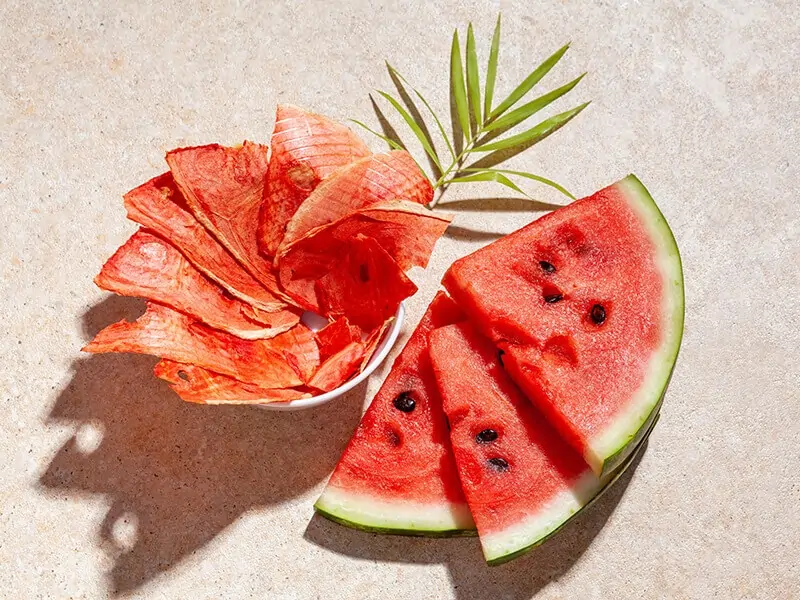
Watermelon is the next fruit I would like to introduce you to this list. It is a type of vine planted worldwide with more than 1000 variants. You can enjoy seedless watermelons and yellow watermelons in Vietnam.
Its seeds were discovered in the Dead Sea in the ancient times of Bad Edh-Dhra and Tel Arab. Nowadays, everyone loves seedless watermelons when its total selling volume increased by nearly 85% in 2014 in the US.
It is a large fruit with a thick and hard rind. This section usually has dark green and vertical stripes. The most valuable thing about watermelon is its sweet flesh. It is red or yellow with a lot of tiny black seeds.
Its sweet flavor and juiciness are the perfect choice for smoothie or juice processing for hot summer days in Vietnam. It also appears commonly on Tet holiday in Vietnam.
Nutrients: It has vitamin C, potassium, copper, vitamin A, B5 in the nutritional content.
Season: It is famous from May to September.
How to eat: Cut watermelon into small pieces and eat its flesh from the rind. Remember to remove the seeds when consuming. Or, you can cut it into 2 halves and use a spoon to get its meat.
16. Orange – Cam
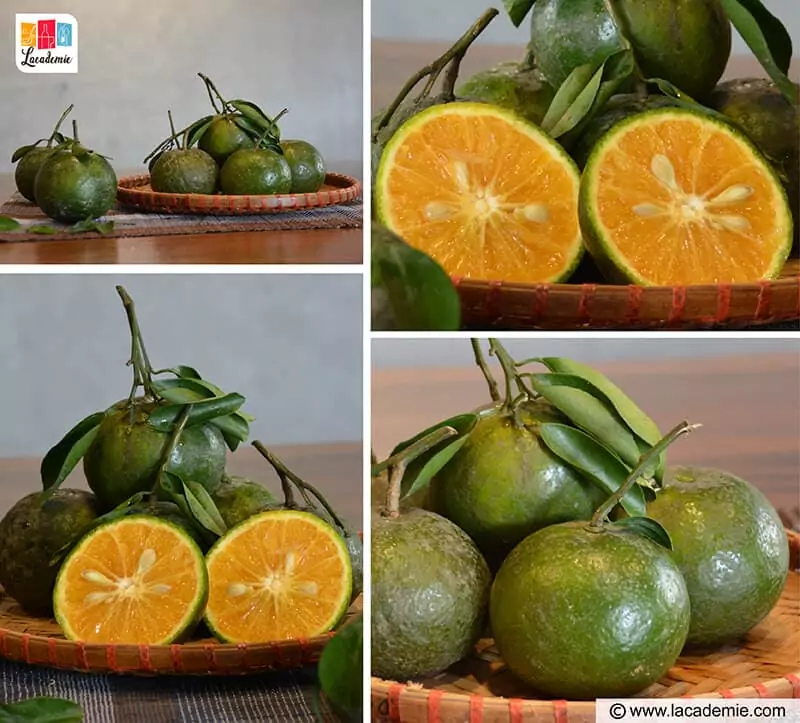
It is easy to find different types of citrus fruit and orange is a one loved by many Vietnamese people in the summer. Therefore, you can catch it everywhere in this beautiful country. Orange has originated in southern China, Myanmar, and Northeast India.
Nowadays, orange cultivation takes place around the world. There are about 79 million tons of oranges produced in 2019. Brazil, China, and India are the 3 countries with the highest yield globally. In Vietnam, orange often has green or light green skin.
Cam Xoan and Cam Sanh are two common types of orange in Vietnam. Cam Xoan has a low amount of sweet juice and light yellow flesh. Meanwhile, Cam Sanh has more liquid, deeper shades, and a robust sweet and sour flavor.
Nutrients: Plenty of calories, fiber, vitamin C, A, and calcium.
Season: It is available from September to April in Vietnam.
How to eat: The easiest method to eat an orange is to peel and separate its segments to consume. Or, you can cut it into slices vertically and eat its flesh from the skin. In addition, it is possible to slice into 2 halves and press juice to drink.
17. Tangerine – Quýt
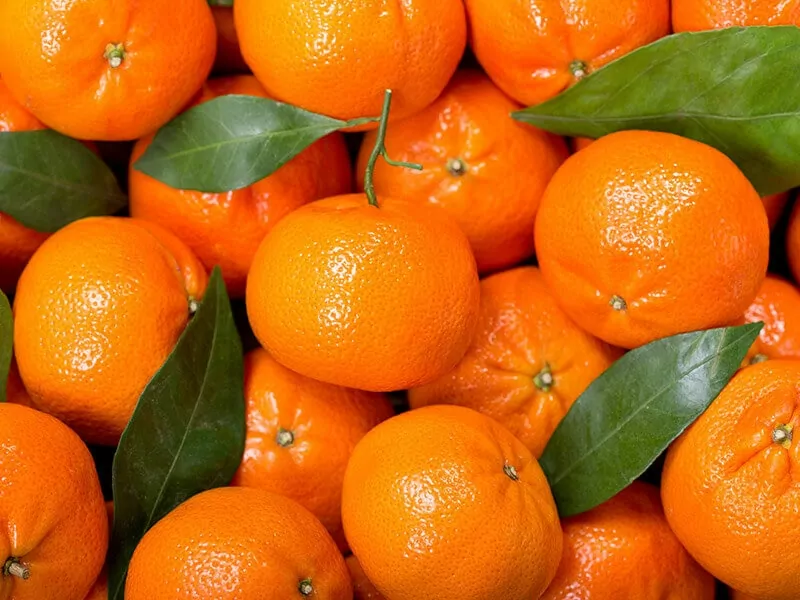
Tangerine is one of the orange types. Tangerine cultivation took place first in Palatka of, Florida. It belongs to Mandarin varieties. Compared to conventional oranges, it is smaller and less round.
In Vietnam, tangerine is often sold with light green skin, and you can easily peel it by hand. It has about 10 segments with a thin film layer wrapped around it. It is sweet and tastes more potent than common oranges.
Tangerine is also a famous Chinese dessert recipe when this country also planted many tangerines. Compared to China’s tangerine, the Vietnamese version will be less sweet. Vietnamese people often eat raw tangerine or make drinks and jams with it.
Nutrients: Get calories, sodium, carbs, fiber, vitamin C, and protein from Tangerine.
Season: The season extends from September to March.
How to eat: You can enjoy Tangerine as you enjoy oranges.
18. Langsat – Bòn Bon
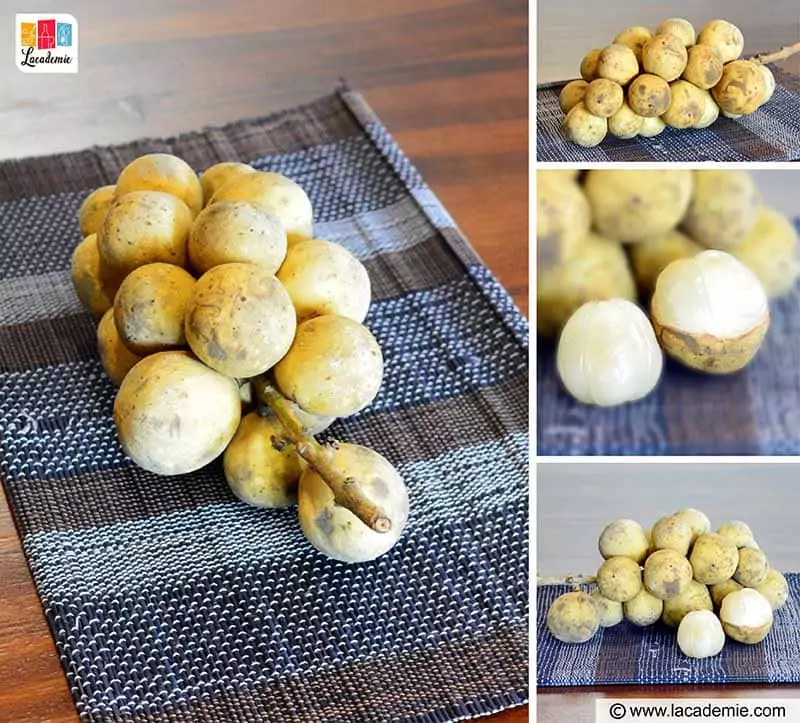
Langsat or Langzones, Longkang is a fruit belonging to the Mahogany family. It originates in Southeast Asia and is a well-loved fruit in Malaysia, India, and Vietnam. The larger version of it is known as Duku. Langsat is the ideal choice for making appealing types of syrup.
You can see Langsat in the round, ellipse, or oval shapes. You will think of a small potato when looking at Langsat. A thin and yellow hair layer will cover its thick shell. The thickness of the skin depends on different types of Langsat.
After removing the skin, it looks like peeled garlic. It contains about 4 to 5 sections, and each section will include a seed. You will feel a sweet and sour flavor when consuming it. Its flavor is a combination of grapefruit and grape.
Nutrients: Rich in protein, carbs, minerals, fiber, vitamin A, thiamine, and riboflavin.
Season: Its season usually falls in June and July, and it happens in December and January again.
How to eat: You just need to peel its skin and eat flesh around the seeds. It is good to use it to make jams, juices, or desserts.
Let’s try the outstanding flavor of Langsat right now.
19. Peach – Đào
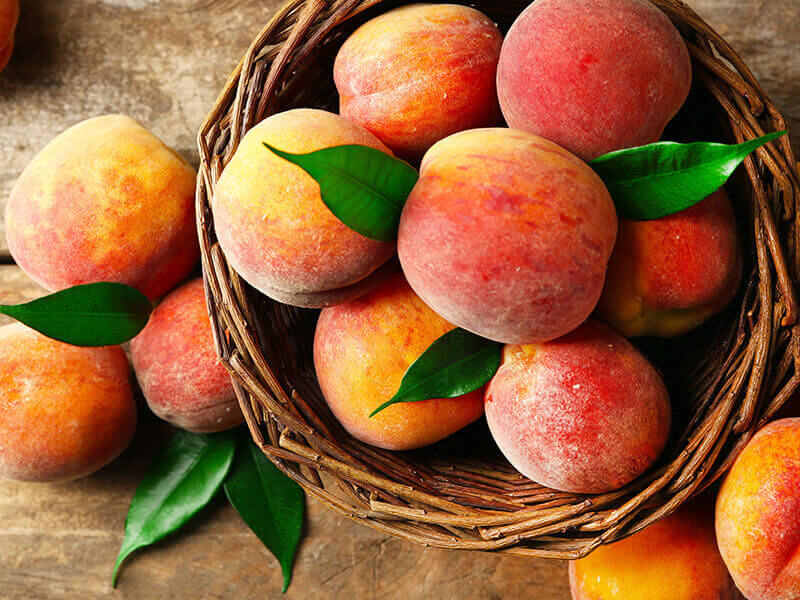
Peach is an edible fruit you should not ignore when coming to Vietnam. Although it has originated in Northwest China, it is popular in Vietnam and many other Southeast Asian countries. It is widely planted in the northern provinces of Vietnam.
Ripe peaches will have a pink-orange color. There is yellow or whitish flesh inside. In particular, the delicate and appealing aroma of peaches will leave a deep impression in your mind while consuming.
The flavor of peach is a combination of sweetness and tanginess. Typically, the peaches in Asian countries will be less sour than peaches of European and North American countries. You should remove its seed when eating.
Vietnamese people often eat a raw peach or add in teas and process desserts. China produced the most peach when accounting for about 62 percent of total peach output worldwide.
Nutrients: It includes calories, fat, carbs, sugar, fiber, protein, vitamin A, and C.
Season: Its season runs from May to late September.
How to eat: You just need to choose a ripe peach, peel the whole skin and eat around the seed. If you use it for cooking, you should cut it into 2 parts and remove seed before using.
20. Ambarella – Cóc
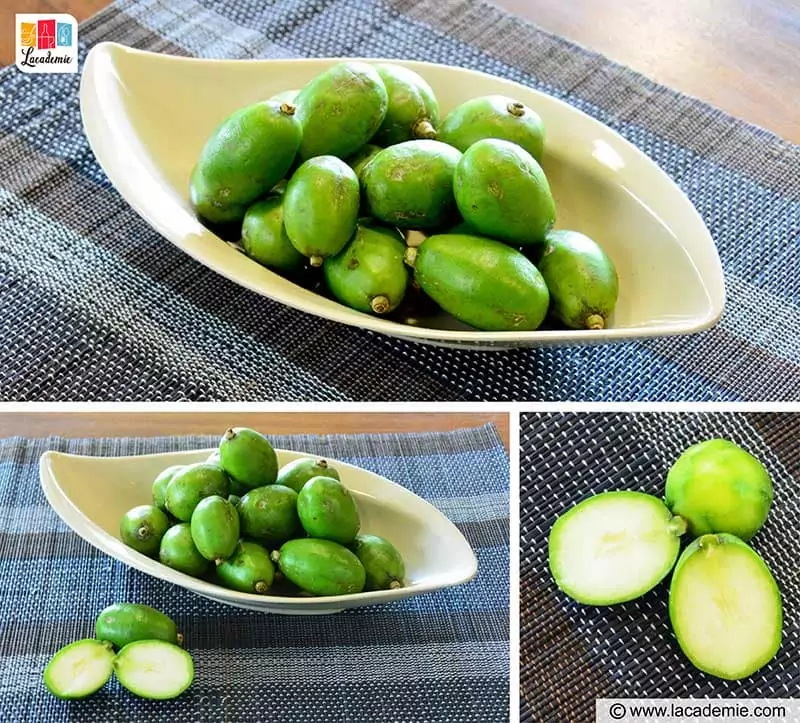
Ambarella is a familiar fruit with all Vietnamese people. It has a single fibrous pit in the center. Also, it is known as “Golden Apple” in English. It is native to Polynesia and Melanesia. It is an essential element in Vietnamese cuisine.
It has a typical oval shape. There are about 12 fruits in a bunch. Unripe Ambarella usually has a green and problematic skin. It will fall off the tree when it is still green. It will have golden-yellow color when ripe.
Its flesh is pretty crispy and sour, and you can feel a bit of sweetness from Ambarella. It has a seed in the middle. Vietnamese people often eat raw Ambarella with salt and chili. Furthermore, it is pickled with sugar and saltwater.
Nutrients: Calories, carbs, calcium, vitamin A, C, and iron are dominant nutrients of Ambarella.
Season: It is famous from May to October in Vietnam.
How to eat: Vietnamese often peel its skin and dip it into salt or shrimp paste and eat its flesh around the seed. It is also used to make jelly, jams, syrup, or add to many other foods.
21. Pomelo – Bưởi
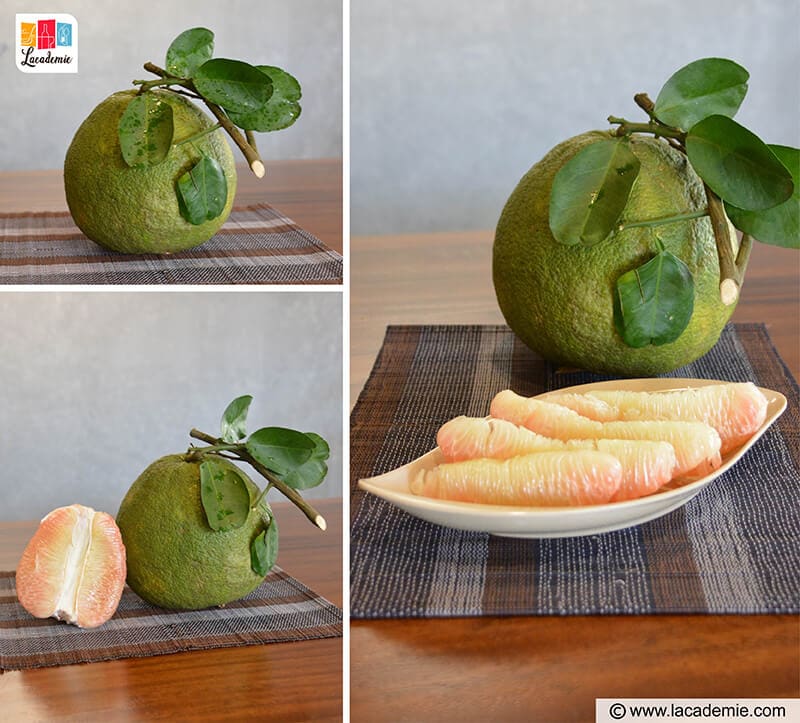
Pomelo is considered the ancestor of grapefruit. It originates in Southeast Asia, and is a popular fruit in festivals in this region. It appears in many places in Vietnam and is popular in Ben Tre, Vinh Long, and Dong Nai.
Vietnam has famous types of pomelo, such as Nam Roi, Da Xanh, and Bien Hoa pomelos. You will find a thick and green rind wrapped around pomelo. After peeling, there are many light pink or yellow segments inside.
Compared to grapefruit, its flavor will be lighter and mixed with bitterness. However, it seems sweeter than grapefruit. And, there is indispensable a slight sourness of citrus fruit. Usually, pomelo will be harvested from August to December in Vietnam.
Nutrients: It is time to get carbs, negligible fat, vitamin C, calories from Pomelo.
Season: Its peak season takes place from August to December in Vietnam.
How to eat: It is simple when you just need to peel Pomelo off and cut it into 2 halves. Separate each citrus to enjoy. You need to peel the pith before consuming.
Seedless or Edible Seed Fruits
If you do not want to waste time to discard seeds while consuming, you should refer to these suggestions in this part. It consists of mouthwatering Vietnamese seedless fruits.
22. Dragon Fruit (Pitaya) – Thanh Long
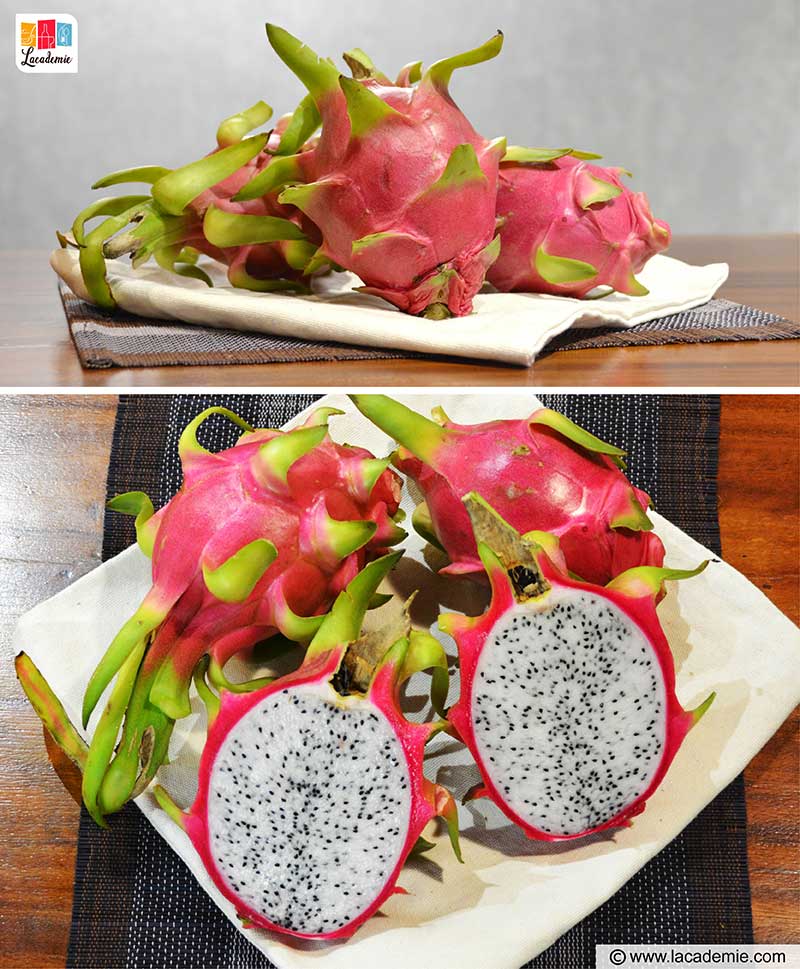
Dragon fruit is a popular fruit in Vietnam. It is native to many regions like Mexico South America, and it is grown much in Southeast Asia, East Asia, Australia, and tropical countries around the world.
Its “dragon fruit” name began to be used in 1963. Besides, it also has another name Pitaya. Its scales look pretty similar to that of a dragon and the spikes are the same as fire. And they lead to its unique name.
Dragon fruit includes a soft and thick skin with many green tentacles. Its peel is usually pink when ripe. When peeling this skin, you will notice white or pink flesh and countless edible tiny seeds.
Its flavor is pretty gentle. You can feel a sour and sweet taste when consuming dragon fruit. It is a suitable fruit for health and contains many nutrients. The pink flesh version will be more delicious and have more nutrients.
In Vietnam, dragon fruit cultivation is common in Southern and South Central Coastal provinces. In particular, Binh Thuan province is the most dragon fruit producer in Vietnam.
Nutrients: It consists of carbs, calories, vitamin C, calcium, fiber, and sodium.
Season: Its season lasts from April to October and the peak time runs from May to August.
How to eat: You need to peel the Dragon fruit off and cut it into small pieces to eat. In addition, you can cut it into slices and eat its flesh out of the skin.
Expand your knowledge with exciting facts about Dragon Fruits.
23. Passion Fruit – Chanh Leo
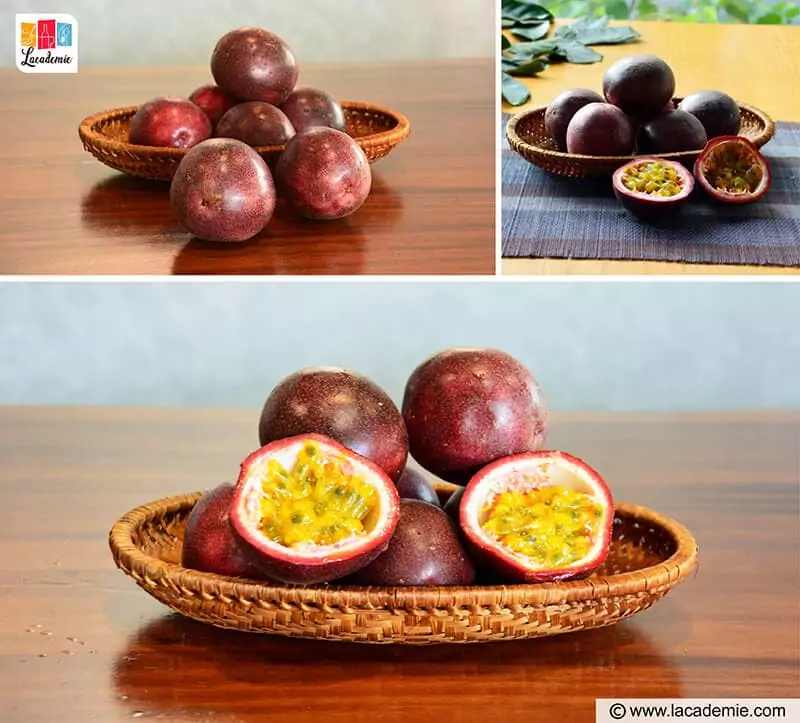
Passion fruit is an essential component in Vietnamese drinks. It is a tropical fruit with round or oval shapes. You can find passion fruit with yellow, red, purple, or green shades. Its flesh is juicy and has a lot of large seeds in the middle.
Its flavor combines sourness and sweetness, so it is usually combined with many other fruits in cuisine. Delicious Vietnamese foods from passion fruit include passion fruit ice cream, cocktails, juice, or jams.
There are 4 main different types of Passion Fruit: purple, yellow passion fruits, sweet granadilla, and giant granadilla. Passion fruits in Vietnam will often come in yellow or reddish rinds. This fruit is a rich source of carbs, calories, and vitamin C.
Nutrients: A rich source of carbs, protein, calories, vitamin C, riboflavin, niacin, iron, and phosphorus.
Season: Its season lasts from summer to winter.
How to eat: Peel apart of its skin and eat flesh and the seeds inside. Also, you can cut on its top and squeeze is juice to drink.
Follow these instructions to enjoy Passion Fruit properly.
24. Starfruit (Carambola) – Khế
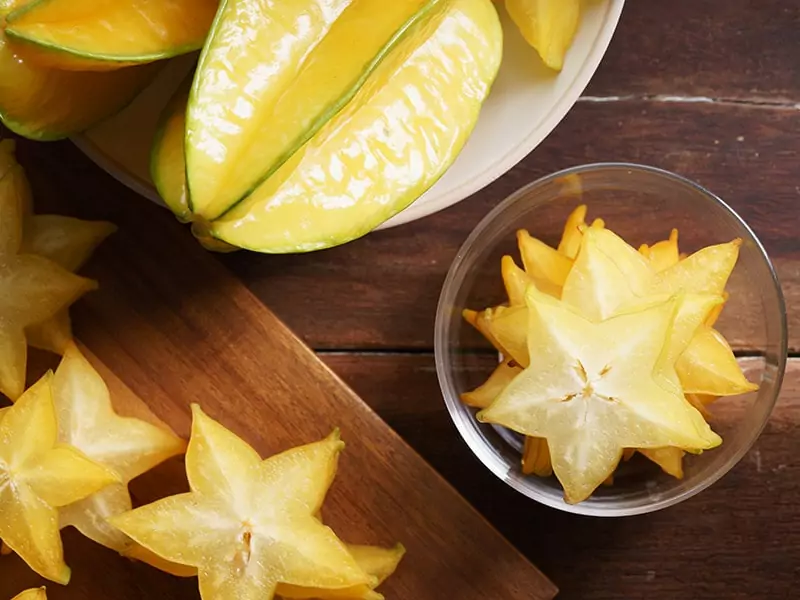
Starfruit or Carambola, five fingers is native to Southeast Asia. It is also famous in Brazil, East Asia, America, and the Caribbean. It appears year-round in the Mekong Delta and Central Vietnam.
Starfruit has a reasonably featured appearance when wearing a layer of thin and waxy skin. Typically, it will have orange-yellow color. There are about 5 to 6 dominant longitudinal ridges around starfruit, so you will have star-shaped slices when cutting horizontally.
When ripe, its flesh will be yellow and succulent. You will feel the tartness when biting it, and the sour taste will decrease as it is ripe. You can think of lemon or kiwi flavor when consuming starfruit.
It is a beneficial fruit for anti-inflammatory, weight loss, stabilizing blood pressure, and improving the digestive system. Vietnamese often use it for salads, curries, desserts, or drinks in cuisine.
Nutrients: It is good to supplement carbs, fat, calories, vitamin C with starfruit.
Season: It is available all year-round in Vietnam, but people usually harvest it in August, September, October if it blooms from April to May. Meanwhile, the harvest will occur in December, January, and February when blooming from September to October.
How to eat: You can eat the whole starfruit after rinsing it with water.
25. Guava – Ổi
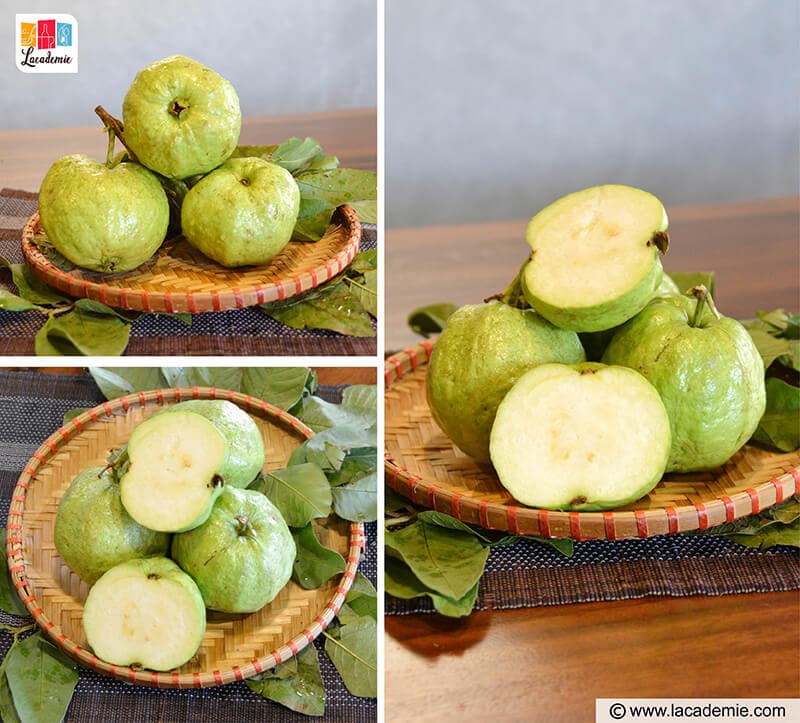
Although guava is native to Central America, it is common in Vietnam and many Asian countries. It is a popular dessert fruit after each Vietnamese meal. It is grown much in the Mekong Delta, Thai Binh (Oi Bo), Ha Noi (Oi Gang), Bac Giang, and Hung Yen.
Its shape looks like a pear, and its size is the same as a baseball. It has a thin, green, edible skin, and the peel has a bitter or sweet taste. You will love the sourness and sweetness of white or dark pink pulp with countless tiny seeds.
It is possible to eat unripe or ripe guava. The unripe version will be more crispy than the mature version but less sweet. It contains lots of vitamin B, C, A, E, and good minerals for heart and eye health.
Nutrients: Rich in dietary fiber, vitamin C, folic acid, calories, and minerals.
Season: You can eat it year-round in Vietnam.
How to eat: Thanks to its edible skin, you just need to rinse and cut it into pieces to eat. If you do not like the bitter flavor of the skin, you can remove it with a knife. It will be better when eating with chili salt.
26. Banana – Chuối
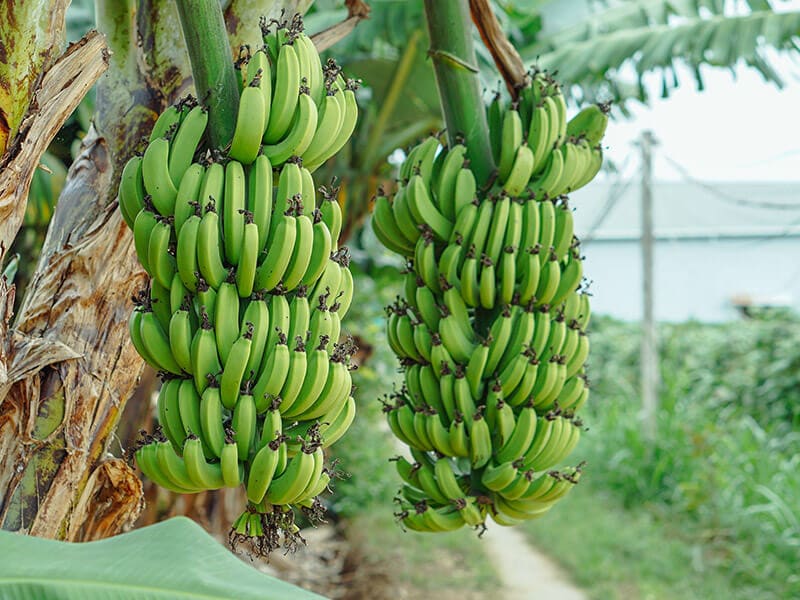
It is a shortcoming if I do not mention banana in this list. It is an elongated fruit and it is known as plantains when using for cooking in some countries. In Vietnam, it is an incredible fruit for desserts and cooking.
The tenderness and smoothness of its flesh will not disappoint you. It has white shade and attractive fragrance when ripe. It is protected by a thick and soft skin. Its peel will be yellow, green, purple, red, or brown.
There are different types of bananas in Vietnam that you can try like Cau bananas, Ngu bananas, Tieu Bananas, and Hot bananas. Sourness and sweetness are the two dominant flavors of bananas, but the sweetness will be stronger when ripe.
Besides being a dessert fruit, bananas also appear in smoothies and many delicious foods. Vietnamese people use young bananas to add to salads or soups.
Nutrients: It is a source of calories, protein, carbs, sugar, fiber, and vitamin C.
Season: You can buy it all year round in Vietnam.
How to eat: It is easy to eat a banana when you just need to peel its rind and consume its flesh.
27. Coconut – Dừa
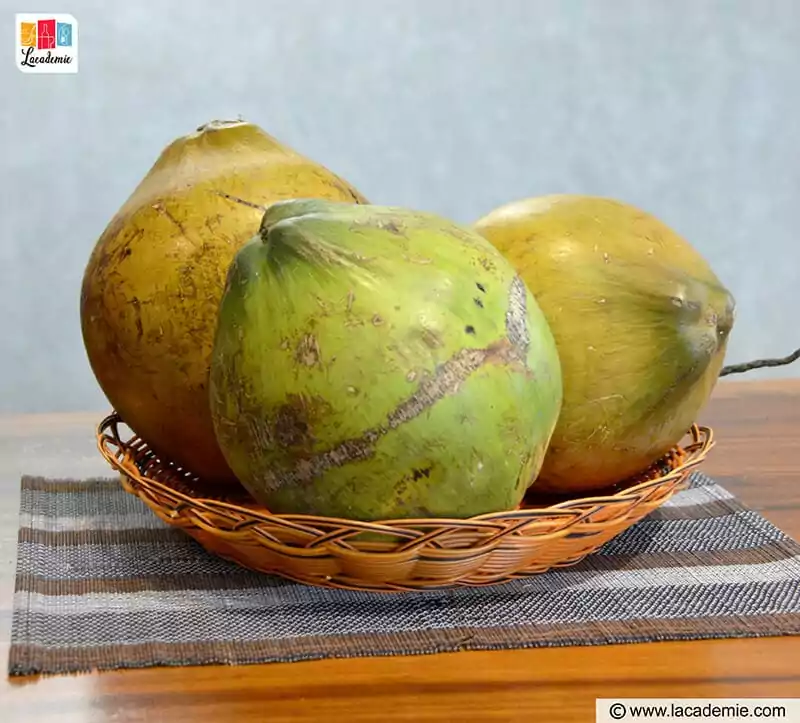
Coconut is a type of drupe. Its name originated from the word “Coco,” which means “head” or “skull” in Portuguese. It appeared for the first time in the Central Indo-Pacific region. Its popularity is associated with the migrations of Austronesian peoples.
Exocarp, mesocarp, and endocarp are 3 parts that make up the outer layer of coconut. The outer green or brown skin is called the exocarp. Mesocarp is tightly connected fibers that make a thick layer. Endocarp is the hard shell part of the coconut.
There is a circular gap in the middle of coconut, containing coconut water. Coconut water is an excellent beverage for you in the summer. It has a sweet and delicate flavor. Vietnamese people use it to increase flavor for stews, soups, or braises.
Coconut meat is white and soft. It is the main component to make coconut milk, and you can enjoy fresh coconut meat. Ben Tre province is the most coconut producer in Vietnam.
Nutrients: Calories, fat, carbs, fiber, and sugar.
Season: It is available year-round in Vietnam.
How to eat: The most common way to eat coconut is to create a hole at its bottom and get water out of the coconut. To consume coconut meat, you just need to cut it into 2 parts and take a spoon to get its meat.
28. Nipa Palm – Dừa Nước
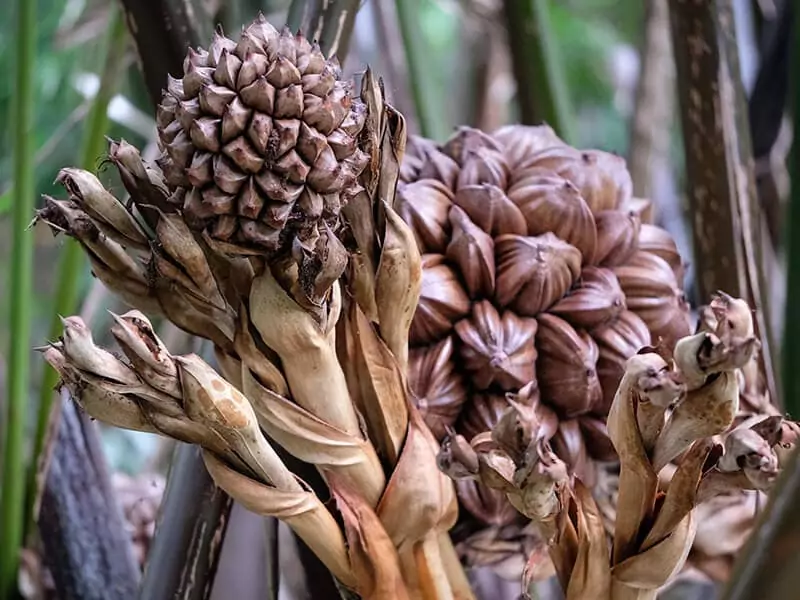
It is not complicated to see Nipa Palm when traveling along the river banks in the Mekong Delta in Vietnam. It is native to the coastlines of the Indian and Pacific Oceans. You can only see leaves and flowers emerging on the water.
The bunches of Nipa Palm are created from the small Nipa Palm fruits. They often have the size of an egg. You will need a knife to separate the Nipa Palm from its bunch. After cutting into 2 halves, a layer of white flesh will appear.
Its flesh has a soft and smooth texture. Its flavor is pretty similar to a coconut meal. Especially, its natural sweetness will be an incredible suggestion to dessert. People also use Nipa Palm leaves to build their homes.
Nutrients: It has a lot of sucrose, glucose, and fructose.
Season: It is available all year-round in Vietnam.
How to eat: To consume Nipa Palm, you need to cut it into 2 halves and use a spoon to get its whitish flesh.
29. Pomegranate – Lựu
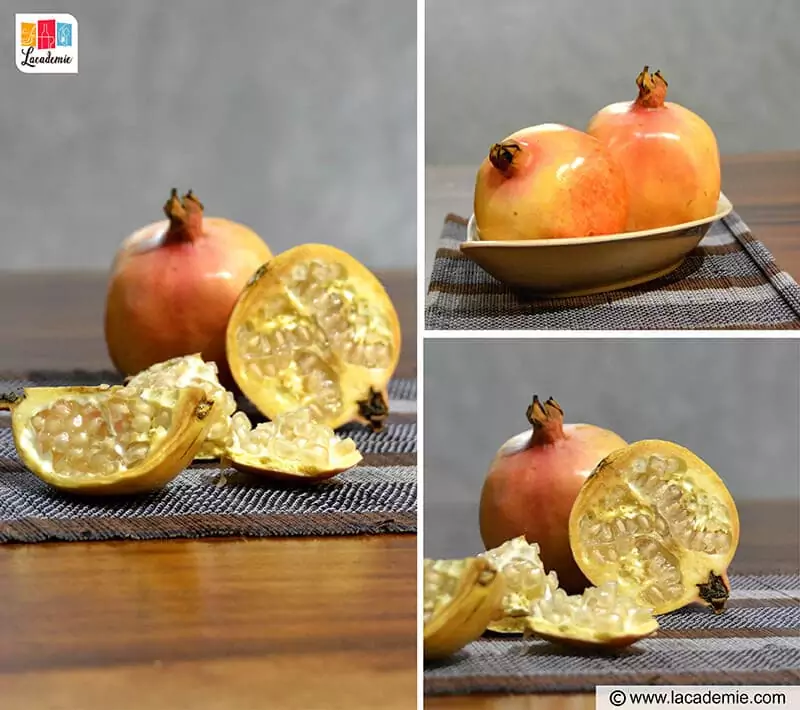
If you love Vietnamese fruits, you will not be strange with Pomegranate. It is native to the Mediterranean region. In Southeast Asia, it is also famous in Thailand, Malaysia, and many other countries.
Its season will vary in two hemispheres. It is ripe from October to February in the Northern Hemisphere, while its season starts in March and ends in May in the South Hemisphere. It is a famous smoothie, beverage, cocktail, and wine element.
You will be impressed with its distinctive red-purple color. Its husk includes a hard pericarp and spongy mesocarp. It contains numerous tiny seeds inside (200 to 1400 seeds). These seeds are red or white. Their juiciness and sweet-sour flavor will make you flutter.
Nutrients: A source of calories, protein, fat, carbs, sugar, fiber, calcium, and iron.
Season: Normally, it is ripe from September to November.
How to eat: To eat succulent pomegranate seeds, you need to use a knife to cut it into 2 parts (you can use your hands).
30. Buddha’s Hand or Fingered Citron – Quả Phật Thủ
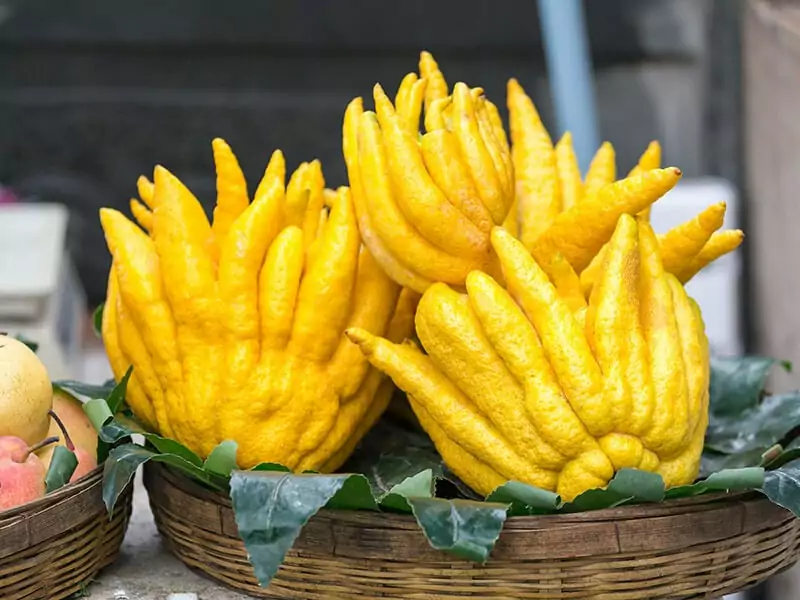
Buddha’s Hand is a unique fruit with a special appearance. It looks like a hand that is created from many fingers. Its shape is pretty diverse when you can find open-hand or closed-hand versions.
This fruit has originated in northeastern China and India. It is considered a kind of citrus fruit. Its appearance stands out with colorful yellow skin when ripe. It has a small and sour pulp inside. However, it is often juiceless and seedless.
You will love its fragrance. Vietnamese people often do not eat raw Fingered Citron, and they will take advantage of it to prepare alcohol or jam to offer Buddha.
Nutrient: It has a high amount of calcium, dietary fiber, carbs, volatile oils, vitamin C.
Season: The season starts from late October to January (Mid-November is the peak season).
How to eat: The easiest way to eat Fingered Citron is to slice it and put it into salads or dishes.
If you are curious about Fingered Citron, let’s explore all things about it now.
Have you ever tried any Vietnamese fruit on this list? Have you ever traveled to Vietnam? It is time to take a trip to this gorgeous and friendly country to try these delicious fruits and experience the nation’s unique traditions and cultures.
After reading this article, I am looking forward to receiving your feelings and feedback, so feel free to leave them in the comment section. Do not forget to share this post with your loved ones to introduce these fruits. Thanks a lot.
